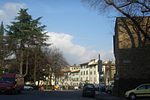Santa Maria del Carmine, Florence
Baroque architecture in FlorenceBasilica churches in FlorenceCarmelite churches in ItalyCarmelite monasteries in ItalyMonasteries in Tuscany ... and 1 more
Rococo architecture in Italy

Santa Maria del Carmine is a church of the Carmelite Order, in the Oltrarno district of Florence, in Tuscany, Italy. It is famous as the location of the Brancacci Chapel housing outstanding Renaissance frescoes by Masaccio and Masolino da Panicale, later finished by Filippino Lippi.
Excerpt from the Wikipedia article Santa Maria del Carmine, Florence (License: CC BY-SA 3.0, Authors, Images).Santa Maria del Carmine, Florence
Piazza del Carmine, Florence Quartiere 1
Geographical coordinates (GPS) Address External links Nearby Places Show on map
Geographical coordinates (GPS)
| Latitude | Longitude |
|---|---|
| N 43.768 ° | E 11.2439 ° |
Address
Basilica di Santa Maria del Carmine
Piazza del Carmine
50123 Florence, Quartiere 1
Tuscany, Italy
Open on Google Maps











